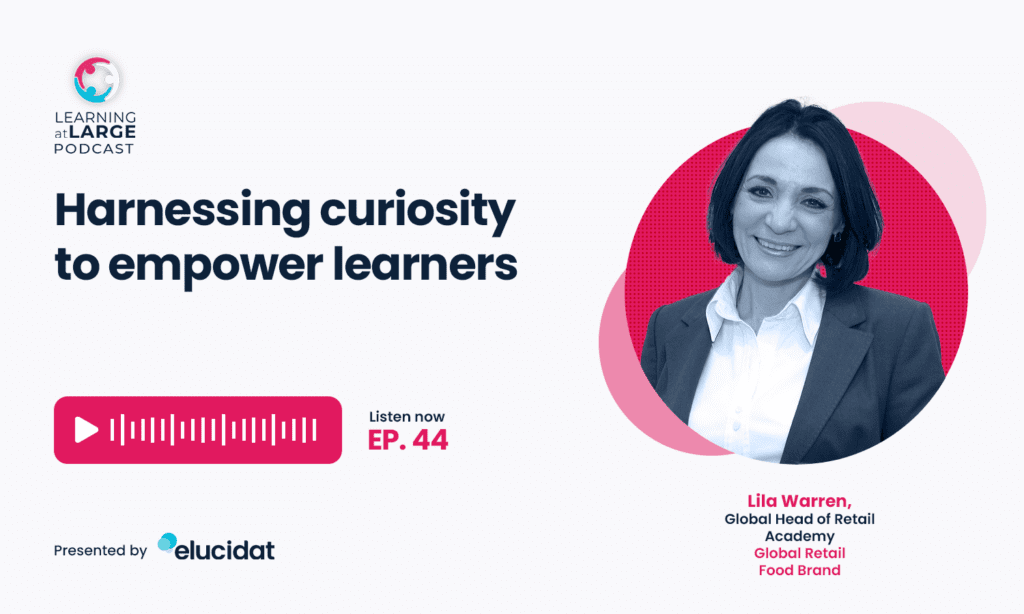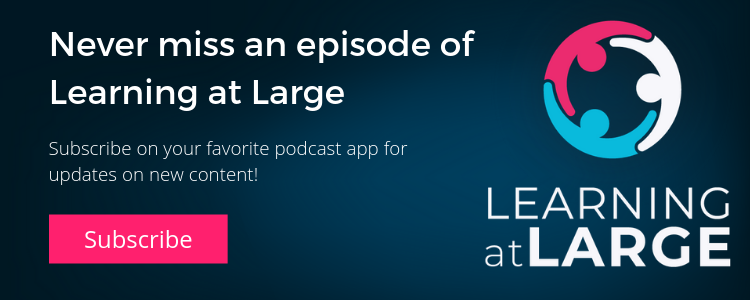Harnessing Curiosity To Empower Learners: Lila Warren
“The mind that opens to a new idea never returns to its original size,” said Albert Einstein. Hear how Lila Warren, Global Head of Retail Academy at a global retail food brand, is putting this idea at the heart of her learner-led approach. Find out why she’s harnessing curiosity and empowering her people to find the answers themselves, and discover how to shift from serving things up on a plate to enabling people to own their development.

Top tips for taking a learner led approach
Don’t have time to listen now? Here are some top tips from Lila:
- Empower people to find the answers: Don’t provide all the solutions. Empower your people to discover the best way to get the knowledge and skills they need.
- Use curiosity to motivate them: Focus less on formal training and more on social learning to harness the power of your people’s curiosity.
- Shift from serving up content: Instead of creating content, think strategically. Set up frameworks with clear roles and responsibilities to support a learner led approach.
- Put yourself in your learners’ shoes: Context is key. Understand the environment where learning takes place. Make sure your approach works in this setting.
1. Empower people to find answers
For Lila, the most rewarding part of her role is setting someone on their own journey of growth. It’s not about assigning hours of learning content that people have to complete. It’s about enabling them to go out and get the knowledge and the skills they need in their role and career.
This learner led approach isn’t just good for employees. Increasing accountability and driving behavioral change, it’s just what the retail industry needs right now.
“No one likes to feel incompetent or awkward at work. When we know what we need to learn and where to get the information to learn, and we feel safe in the way we’re going to learn it, it becomes empowering. It also increases the motivation to learn.”
2. Use curiosity to motivate them
Einstein said “Curiosity is more important than knowledge.” And Lila totally agrees. Businesses rely on their employees achieving the necessary, expected and desired performance level. Just giving them knowledge is not enough to achieve this.
Looking at the 10 20 70 model, this means focusing less on that 10% of formal training and more on the 20% of social learning. This is where you can harness, and even increase, your learners’ curiosity. Rather than giving people the solutions, empower people to discover the best way to learn, from the best people on the shop floor.
“We can sometimes be guilty of putting out a lot of content and expecting that the learner is going to be trained and reach the performance level desired. But if it’s only 10%, it isn’t going to reach the ultimate goal. Right? Now, the 20% [social learning], that’s about increasing the learner’s curiosity… Direct them to who can help, where they can find the resources, where they can find the solutions and answers, but don’t give them the answers and the solutions. When we get that we really activate the curiosity in them. And curiosity leads to action.”
3. Shift from serving up content
If retail businesses are to create the behavior change needed to thrive, L&D has to take a new approach. There needs to be a shift from creating learning to empowering employees to get the development they need, when they need it.
Lila focuses her energy on a learner led strategy and the frameworks that support it. By setting out clear roles and responsibilities for everyone – learners, colleagues, line managers and L&D – you can create a joint effort and empowered employees.
“Everyone faces the same challenges at the moment: Not having the time to learn. Yet whenever there’s a training need and a knock at L&D’s door, we create content. We create even more content, knowing that there’s no time to complete it. So, we’ve got to spin is on his head. Instead of creating content, we need to rely on the people who have the experience.”
4. Put yourself in your learners’ shoes
Context is always key. If learning is going to be successful, you need to understand the environment where it takes place.
Currently, many retail sites are experiencing high turnover. This will automatically have an impact on your people’s training experience. New employees need to reach competency quickly. Faced with the same customer demands, they have to train in a very pressurized environment. Under these conditions, learning at the moment of need becomes critical.
“We assume that the learner is going to remember exactly what they heard and what they saw. But that’s just a risky assumption. … If I put myself in the shoes of our learners, who are shop based, the environment is very unpredictable. It’s very noisy. It’s very fast paced. Acquiring knowledge must have an element of purpose and concentration. When you’re curious, you’re going to get the information that matters to you right now. Because you’re faced with a situation where having the knowledge becomes essential.”
A quick recap
Recruiting and retaining retail employees is proving more difficult than ever. If you want to engage your employees, Lila has four strategies for taking a learner led approach.
- Don’t provide all the solutions. Empower your people to find the answers for themselves.
- Focus on social learning. This is where you can harness the power of your people’s curiosity.
- Instead of creating more content, think about how you can support a learner to access the learning they need, when they need it.
- Put yourself in your learners’ shoes to understand the environment where this training takes place.
Want to find out more? Check out the full podcast.
About Lila
Over a 22-year career at Pret a Manger, Lila has worked in a number of roles. From the shop floor to the L&D department, she uses this experience to deliver a learner led strategy to employees across the globe. She’s a qualified Counsellor-Psychotherapist, which informs her L&D work.
You can find out more and get connected with Lila on LinkedIn.
On Lila’s reading lists
Find out what recent reading has informed Lila’s work.
Impact Players: How to Take the Lead, Play Bigger, and Multiply Your Impact, Liz Wiseman
How do you move from being a contributor to an impact player? Lila says this book is a great source of useful models and practical exercises that can help you decide where to focus and make a positive difference.
Looking for more reading tips? Check out our book blog.
Join the conversation!
We’d love to hear your thoughts on our podcast, so feel free to get in touch on Twitter @Elucidat with any questions or queries. You can also email Kirstie, our podcast host, at kirstie.greany@elucidat.com. As always, don’t forget to subscribe to Learning at Large in your favorite podcast app and leave us a 5-star rating if you enjoyed it. Thank you for joining us, and see you next time
